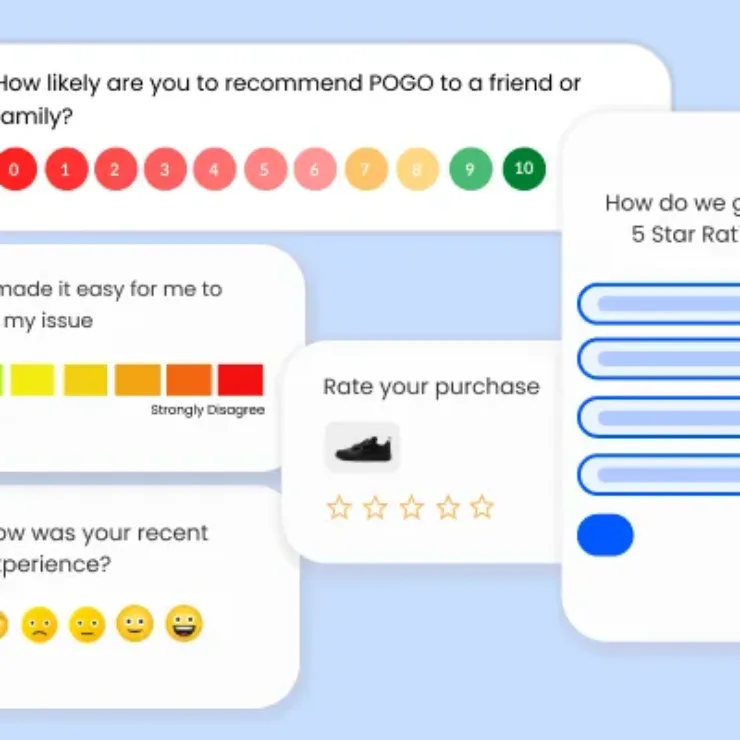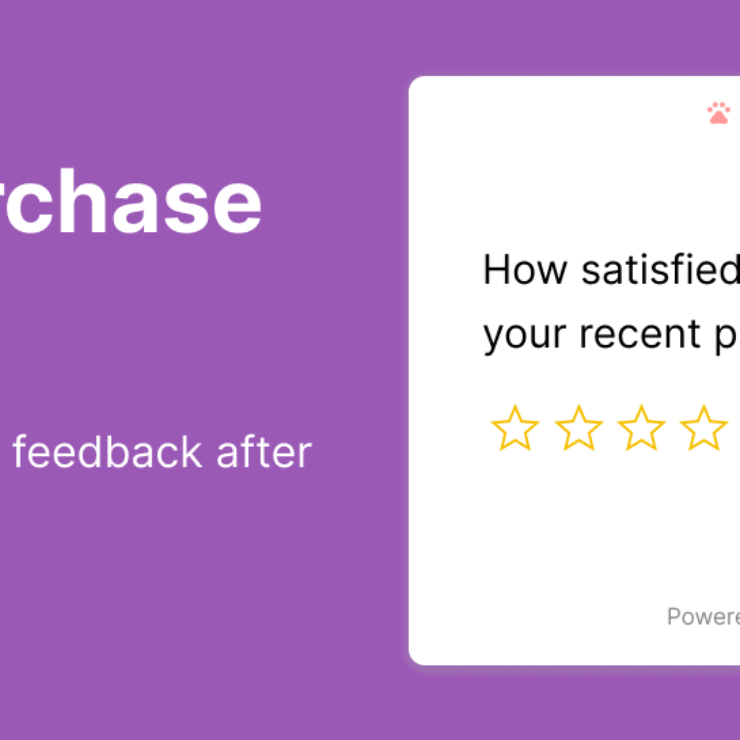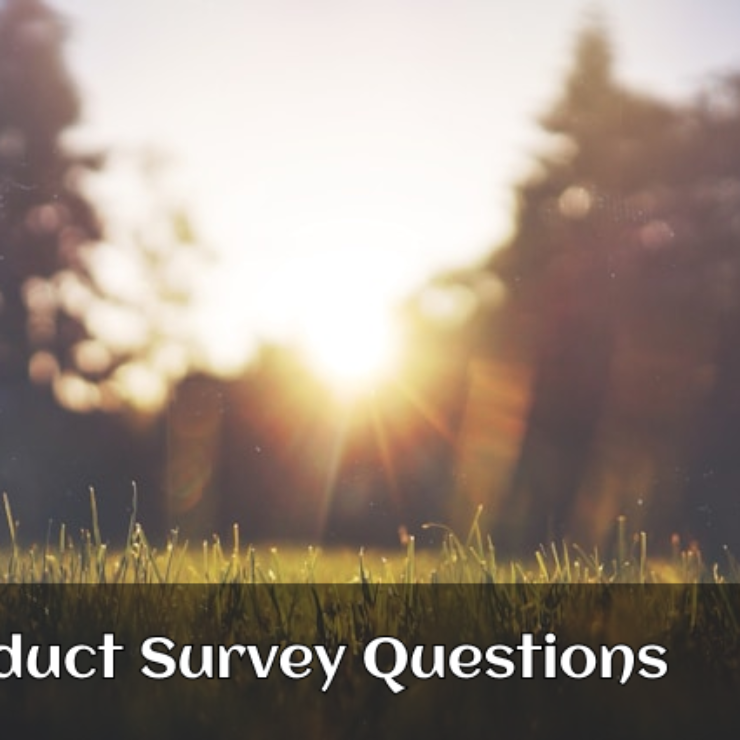Last updated on:
Voice of customer, also known as VoC in its short form, refers to the feedback that customers provide to a business. “Listening” to the voice of customers enables a business to learn from customer insights and issues that impact them. Collecting and analyzing the VoC data can lead to better products or services which results in improved customer experience. Voice of customer template is a survey template, which contains a set of questions that can be used to survey your customers. It can be in the form of an NPS survey template, a CSAT Survey template, or a custom voice of customer survey template that can be used to get customer feedback.
In today’s competitive world, customer experience is paramount for business growth. In the US, 59% of the customers will walk away after several bad experiences according to this study. 17% will stop using the company product or services after just one bad experience. On the positive side, customers are likely to spend 140% more after a positive experience than customers who had a negative experience as per this article. Capturing the VoC, also known as “listening” to your customers is the first step towards providing a great customer experience.
This post helps you understand the voice of customer survey process and provides you with the voice of customer templates, that you can use to send out voice of customer surveys.
Table of Contents
TL;DR
- In the simplest terms, voice of customer survey tries to capture customer insights at various points of the customer journey.
- A voice of customer template is used to send out the surveys at individual touchpoints as well as at specific intervals.
- Voice of customer template uses a combination of qualitative and quantitative voice of survey questions to get insightful customer feedback.
- It’s a good practice to send out the voice of customer surveys on a continuous basis at various touchpoints as opposed to doing it as a one-time exercise or a periodic one.
- The responses to the voice of customer surveys can help improve customer experience. The voice of customer template should contain relevant questions to identify the customer’s pain points. These questions can be both quantitative and qualitative. The response to the questions can help you identify the problem areas in the customer journey. Working on removing these issues can help you provide a great experience to your customers.
- The Voice of customer template can also contain other types of questions to generate new product ideas, improve existing products, do customer research, understand brand loyalty, and competitor research among others.
- Some of the popular voice of customer surveys are – Net Promoter Score (NPS) survey, Customer Satisfaction (CSAT) survey, and Customer Effort Score (CES) survey.
- You can get the voice of customer using various methods – customer interviews, focus groups, online surveys, customer chat with support, online and social reviews, analyzing support tickets, etc.
- While using a voice of customer template, you should ensure not to include biased questions. Also, make sure that the voice of customer template is short and concise. Based on our research, we recommend not more than 7 questions in the template.
- For voice of customer survey, you can use appropriate context. For example, send the survey after the user has done a transaction or used a particular feature. However relational surveys like NPS can be sent periodically to assess customer loyalty.
- To seamlessly create and send out the voice of customer survey to your customers, you can use an all-in-one survey tool like Affiniv. Using Affiniv, you can create voice of customer survey pretty quickly using our voice of customer templates. Once the survey is created, it can be sent out using Email, WhatsApp, Text, etc., or can be embedded in your website or App. Finally, the results can be analyzed using the dashboard, which can provide insights into the voice of the customer.

Want to create and send voice of customer surveys in minutes?
With Affiniv, you can create beautiful VoC surveys and send them instantly via Email or Embed in your website/app.
What is Voice of Customer template?
Voice of customer survey aims to capture customer feedback and responses to improve customer experience by making products or services better. These surveys can be sent over several touchpoints during the customer journey. Some of these voice of customer surveys can be sent in the context of a transaction, for example, after the purchase of a product, support ticket resolution, or use of a feature. some of the VoC surveys can be relationship-based like NPS, which can be sent periodically to understand brand loyalty. The voice of customer template provides a set of questions suitable for each of these survey types. The voice of customer template for a CSAT survey after a product purchase will contain a different set of questions than a relationship-based survey like NPS. In this post, we are going explore various types of templates suitable for a number of scenarios applicable to your business.
Why are VoC Surveys so Important?
Learning from the customers is super important for a business. These learning from VoC surveys are beneficial at every stage of the customer journey. Here are the top benefits of using a well-structured voice of customer survey.
- A well-designed voice of customer template can help you gather meaningful responses at every stage of the customer journey. These responses can help create better products and services, which in turn results in a better experience for your customers. Better customer experience can help drive up your revenue by preventing churn, getting more revenue per user, and customer referrals. This can also help identify the customers with bad experiences and gives you an opportunity to correct the same.
- In addition to improving customer experience, the voice of the customer can also help you generate ideas to launch new products and services. Most of the time, your customers have a good understanding of what else they need from a business like yours. Or they may be using products or services from another business, which can be fulfilled by you. These customer insights are absolute gold mines, which can help you ideate and then test out new lines of products or services with your existing customers.
- VoC surveys can also help you find newer marketing channels to reach out to new customers. For example, many of your existing customers could be on a social platform that you don’t leverage for your business yet. This also means that you can also leverage the same to get your new customers as well.
- Voice of customer template can also be used to understand more about your competitors. For example: which of your competitors your customers checked out before making a purchase decision, strength of some of your competitors, etc.
Voice of Customer Template Best Practices
In the next section, we will outline the voice of customer templates suitable for various use cases and touchpoints in the customer journey. But before that, let’s understand some of the best practices for choosing the voice of customer template and appropriate questions.
First, identify your goal and audience. Some of the questions to answer in the starting phase can be as follows. What do you want to achieve or learn from the voice of customer exercise? What is the customer segment that can provide you with this insight? For example, say you want to learn a new feature. Your new customers who have signed up in the last week may not be the best ones as they may not have a full understanding of the existing products. If you want to target a particular set of customers for this purpose, you can appropriately choose the right questions for the voice of the customer template.
When to reach out for feedback? As I have mentioned earlier, the voice of customer survey should be a continuous process. Meaning, you should survey your customers with the appropriate template at various stages of their lifecycle on an ongoing basis. It should not be a onetime or periodic activity. For example: when a customer completes a course on your website, a VoC survey should be sent asking for feedback, either immediately or within a few hours. It should not be that you select all the customers completing a course in a month and send them a survey in one go.
How to send out the voice of customer survey? There are several ways to do a VoC survey. The simplest are over Email or a messaging app like WhatsApp. Other ways could be to embed the survey in the website or App so that customers can respond immediately after they have taken an action.
Start with a rating scale wherever applicable. Choosing a rating scale as the first question sets the tone for the questions to follow. This is especially important for surveys like NPS, CSAT, CES, Smiley face Surveys, etc. Choosing the first question as a rating scale also ensures that a score can be generated on the basis of the most prominent question in the voice of the customer template. Using a voice-of-customer tool like Affiniv, this score can be tracked over periods, say month-on-month or quarter-on-quarter.
Use Quantitative as well as Qualitative questions. Your voice of customer template should contain both quantitative and qualitative questions. Quantitative questions such as scale questions, and choice questions are great for quantifying the result and getting some direct insights. For example a question – “Please rate our product on a scale of 1 – 5”, can objectively tell you whether your customers like, dislike, or are neutral about your product. And you can benchmark this score against other products or industries. But then supplementing this question with an open-ended follow-up question such as – “How should we improve the product?”, can give you a lot of text responses to find out the areas of improvement. Or maybe you can use this question as a multiple choice question with an “other” option where your users can write their feedback. Whichever approach you take, you should make sure to use qualitative feedback to get detailed customer insights.
Avoid biased or leading questions. Last but not least, while choosing questions for a voice of survey template, you must make sure not to ask them a biased or leading question. There are several posts we have written about biased questions that you can check out.
Use the appropriate thank you page. After your customers have filled in the survey, you should show them an appropriate thank you message. If doing a standard survey like NPS, CSAT, CES, Smiley face survey, etc, you should show an appropriate thank you message based on whether they are satisfied/promoters or dissatisfied/detractors. You can also use the thank you page to show your users how to avail of the incentive if you had promised them one for taking the survey.
Voice of Customer Templates for various use cases
Here is a collection of voice of customer templates for various use cases. Choose the right questions based on your customer segment, touch point, and specific use case. Also, you can pick questions from various categories below and customize the questions. For example, while creating an NPS survey, you can take questions from the Brand Loyalty, Performance, Customer Service, and Customer Research template sections.
Brand Loyalty Questions for Voice of Customer Template
- On a scale of 1 to 10, how likely are you to recommend our brand to others?
- How satisfied are you with your experience of interacting with our brand including customer service?
Options: Highly Satisfied, Satisfied, Neutral, Not Satisfied, Highly dissatisfied - What are the areas we should improve to make you like us more? Open-ended or multiple choice with “Other” option.
- How likely are you to continue using our [Products/Services]?
Very Likely, Likely, Neutral, Not Likely, Not at all Likely - In a few words, what are the top reasons to consider repurchasing [products/services] from our brand? Open-ended
- How well does our brand understand your needs and preferences?
1 – 5. 1 – Doesn’t meet my needs at all. 5 – Fully meets my needs - Have you ever considered switching to a competitor’s brand?
Options: Never, Occasionally, Most of the times - If yes, what motivated you to consider the change?
Create a voice of customer survey in minutes with Affiniv 👋🏻 ✨
Create a voice of customer survey quickly with templates, themes, logic, and more. Build surveys like NPS, CSAT, CES, or a custom one. Once created, you can send the survey over Email, or messaging apps or embed the survey within your website or App.
Brand Perception Questions for Voice of Customer Template
- What are the top words that come to your mind when you think of our brand?
- How do you perceive our brand compared to the ones from the same industry?
Options can be Highly Favourable to Not Favourable At All - What are the top qualities of our brand that you find most appealing?
- What are the top qualities of our brand that you do not find appealing?
- Do you consider our brand as an innovator?
Options: Always Innovates, Innovates occasionally, Never Innovates - For the “Never Innovates” selection to the above question – A little bit on why you don’t consider our brand an innovator.
- If there were one or two things that you think we should change in our brand, what would they be?
Product/Service Performance Questions for Voice of Customer Template
- On a scale of 1 – 10, how will you rate the overall performance of our product?
- How often do you face technical issues with our Product?
Options: Mostly Free of Issues, Occasionally, Very Frequently - On a scale of 1 – 5, how well does our product meet your needs?
- Are there any features or functionality that you think we must have in our product?
- How frequently do you use our product?
Options: Every day, Few times a week, Few times a month - What in your mind is the strongest selling point of our product?
- Please rate the following attributes – [quality/UI/Speed]. Each attribute can be asked separately.
- How do you perceive our product in terms of value for money? [1 – Not Good At All. 5 – Great Value for Money].
Brand Discovery Questions for Voice of Customer Template
- How did you hear about our [Brand/Product]?
Options: Social Media, Online Search, Recommended by a Friend/Colleague, Advertising - [If selected Advertising] Please mention the advertisement that brought you to our site.
Options: Radio, TV, Online, Newspaper
Competition Question for Voice of Customer Templates
- Have you ever used [Product/Services] from our Competitor?
- Which of the Competitor’s [product/services] you have used earlier?
- If you’ve used our competitor, what motivated you to choose their products or services over ours?
- How would you rate our [products/services] when compared to our competitors?
Options: Much Better, A Little Better, Similar, A Little Worse, Much Worse - What features of our competitors do you find to be very useful?
- How do you compare our pricing with respect to our competitors?
- Will you consider switching to one of our competitors in the near future?
Website Questions for Voice of Customer Template
- How do you rate your overall experience of our website? Rating Scale 1 – 5
- If selected 3 or below, the follow-on question can be – What needs to be improved on our site?
Options: Speed, UI, Information, Errors or Issues, Others (Please Specify) - In a scale of 1 – 5, how easy was it to find products/features/information on our website?
1 – Very Difficult, 5 – Very Easy - If selected 3 or below for the above question, then the follow-up question can be – What [product/feature/information] were you looking for?
- What would be the features we should add to our website to make it more useful?
- How relevant the content on our website to what you were looking today?
Options: Highly Relevant, Somewhat Relevant, Neutral, Not Relevant, Highly Irrelevant
Customer Satisfaction (CSAT) Questions for Voice of Customer Template
- On a scale of 1 – 5, how satisfied are you with our [Products/Services]?
- How do you rate your overall satisfaction with your recent interaction with customer support?
Options: Highly Satisfied, Satisfied, Neutral, Not Satisfied, Highly dissatisfied - On a scale of 1 – 5, how do you rate the quality of our [Products/Services]?
- How do you rate our communication with respect to news and product updates?
- On a scale of 1 – 5, how well do we handle issues, bugs whenever you report them?
Modes of collecting Voice of Customer Feedback
There are several modes you can consider while planning to collect the voice of customer feedback. Here are some of them. Obviously the online survey are the number 1 choice by far. But that doesn’t mean you should overlook the other methods altogether. Here are some of the popular ones.
Online Survey
This is most obvious choice for a reason. Sending surveys online over a channel like Email doesn’t take much effort and is highly scalable if automated. Also, you can fully personalize the email and send gentle reminders using an all-in-one voice of customer tool like Affiniv.
Apart from sending Email, you can also embed the survey in your website. The survey can be auto-triggered after customer takes an action or visits a page after a few days of subscribing to your product. Again, using a tool like Affiniv, you can create and embed the survey very easily on your website. Web-embed is a very effective mode of collecting the feedback as the customer has your full attention while she or he is using your website.

Customer Interviews
In this mode of capturing the voice of customer, employees talk to customers on an individual basis to get their feedback. This requires time and resources and is much less scalable than the online mode. But the amazing thing about talking to customers one-on-one is, you get a wealth of feedback, which you won’t get otherwise. You can ask probing questions and follow-up questions and get valuable insights. In fact it’s highly recommended that teams talk to customers on a periodic basis.
Focus Groups
Focus groups also give you an opportunity to talk to customers directly but in stead of one-on-one, it’s a group of customers. A group can help you get various views and counter-views, which is important to get an all-round understanding. The word of caution here would be that there may be one or a couple of customers who have a very strong view and can bias the discussion. Make sure to get a balanced perspective from the entire group.
Live Chat
If you have a chat widget on your website, customers may already be asking questions, queries and requesting for help there. You can either chat with customers directly or can refer to the chat transcripts, which were answered by support agents.
Social Media Mentions and Online Reviews
You can go through your social media handles and online reviews. These sources contain feedback which are often unfiltered and provide a good way to understand what the customers truly feel about your products or services.
Finally, you should use a mix of channels. As with most of the things, consistency is the key here. Automating the online survey process can help you save a lot of time and resources. But be mindful of the fact that you should also maintain an in-person touchpoint to have a deeper understanding of your customer feedback.
Conclusion
Okay, so now we have seen what is a voice of customer template, how to pick the right questions, when to do the survey. We have also seen voice of customer templates with questions which you can customize for your business and various touch-points. Also we have explored how to send the voice of customer survey, embed on your website. The entire voice of customer feedback collection may look like needing a lot of work, but with the right tool, capturing the voice of your customers can be fairly straightforward.

Want to start capturing your voice of customer in minutes?
With Affiniv, you can create beautiful voc surveys and send them instantly via Email or Embed in your website/app.




